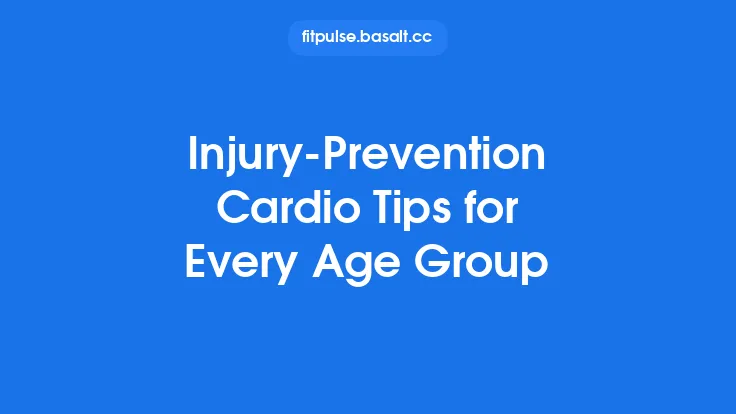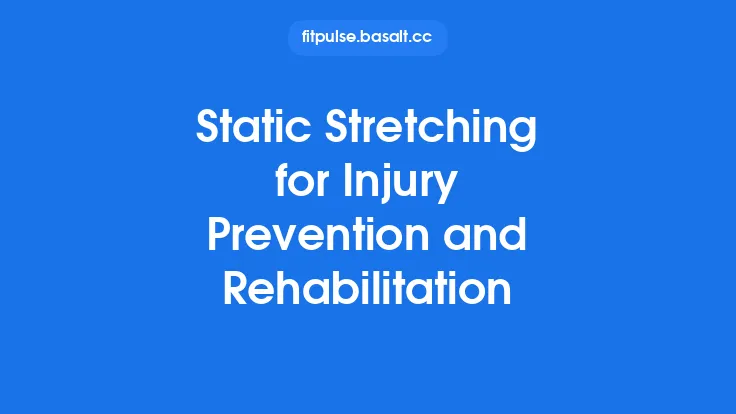Older athletes bring a wealth of experience, discipline, and passion to their sport, but the natural changes that accompany aging also introduce new injury‑risk factors. While the desire to stay competitive is strong, the key to longevity lies in proactive, evidence‑based injury‑prevention strategies that address the unique physiological and biomechanical realities of the senior body. Below is a comprehensive guide that walks you through the most effective techniques—ranging from smart warm‑ups to equipment choices—so you can train confidently, compete safely, and enjoy the game for years to come.
Understanding Age‑Related Risk Factors
Aging does not simply “slow you down”; it reshapes the musculoskeletal system in several predictable ways:
| Change | How It Affects Performance | Typical Injury Implications |
|---|---|---|
| Reduced Muscle Mass (Sarcopenia) | Decreased power output, slower force generation | Strains, especially in the hamstrings, quadriceps, and calf muscles |
| Loss of Tendon Elasticity | Slower stretch‑shortening cycle, reduced shock absorption | Tendinopathies (Achilles, patellar) and overuse injuries |
| Diminished Bone Density | Lower tolerance to impact forces | Stress fractures, especially in weight‑bearing sports |
| Joint Cartilage Thinning | Reduced joint congruence, increased friction | Osteoarthritis flare‑ups, meniscal tears |
| Slower Nerve Conduction & Proprioception | Delayed reaction times, poorer balance | Ankle sprains, falls, and non‑contact injuries |
| Altered Hormonal Profile | Slower tissue repair, reduced collagen synthesis | Longer recovery periods, higher susceptibility to overuse |
Recognizing these changes is the first step toward tailoring preventive measures that compensate for, rather than fight against, the natural aging process.
Comprehensive Warm‑Up Strategies
A well‑structured warm‑up does more than raise core temperature; it primes the neuromuscular system, activates key muscle groups, and prepares joints for the specific demands of the sport.
- General Cardiovascular Activation (5‑7 minutes)
- Light jogging, brisk walking, or low‑intensity cycling.
- Target heart rate: 50‑60 % of estimated max (220 – age). This modest elevation boosts blood flow without imposing undue stress.
- Dynamic Stretch‑Based Mobility (4‑6 minutes)
- Leg Swings (front‑to‑back & side‑to‑side) – mobilizes hip flexors, extensors, and abductors.
- Arm Circles & Scapular Retractions – prepares shoulder girdle for overhead or throwing actions.
- Torso Rotations – activates core stabilizers and improves spinal mobility.
- Movement‑Specific Activation (3‑5 minutes)
- Glute Bridges – fire the gluteus maximus and hamstrings, crucial for hip stability.
- Band‑Resisted External Rotations – protect the shoulder joint by engaging rotator cuff muscles.
- Ankle Dorsiflexion Drills – improve tibialis anterior activation, reducing the risk of ankle sprains.
- Gradual Sport‑Specific Progression (2‑4 minutes)
- Perform the first few technical movements of the sport at reduced intensity (e.g., half‑speed dribbling, light shadow boxing, or low‑impact footwork drills). This bridges the gap between general activation and full‑speed competition.
Key Takeaway: A warm‑up that blends cardiovascular, dynamic, and sport‑specific elements creates a “neuromuscular window” where muscles, tendons, and joints are most receptive to load, dramatically lowering injury odds.
Dynamic Mobility and Activation
Static stretching alone is insufficient for older athletes, as it can temporarily reduce muscle strength. Instead, focus on dynamic mobility—controlled, movement‑based stretches that simultaneously improve range of motion and muscle activation.
- Hip “90/90” Mobilizations: Sit with one leg bent at 90° in front and the other behind; gently rotate the torso toward the front leg. This opens the hip capsule while engaging core stabilizers.
- Thoracic “Open Book” Rotations: Lying on one side, extend the top arm across the body, rotating the thoracic spine. Enhances upper‑body rotation essential for sports like tennis or golf.
- Standing Calf “Rock‑Backs”: Shift weight forward and back while keeping heels on the ground, promoting ankle dorsiflexion and calf elasticity.
Incorporate these drills into both warm‑up and cool‑down routines to maintain joint health and functional range throughout the training week.
Neuromuscular Control and Balance Training
Balance deteriorates with age due to reduced proprioceptive input and slower reflexes. Strengthening neuromuscular pathways can offset this decline and protect against falls and non‑contact injuries.
| Exercise | Primary Target | Progression |
|---|---|---|
| Single‑Leg Stance (Eyes Open/Closed) | Ankle and knee stabilizers | Add a light perturbation (e.g., a gentle tap on the shoulder) |
| BOSU® or Balance Pad Squats | Hip abductors, gluteus medius | Increase depth or add a medicine ball press |
| Lateral Step‑Overs (over a low hurdle) | Dynamic lateral stability | Increase hurdle height or speed |
| Perturbation Walking (using a resistance band attached to a partner) | Whole‑body coordination | Vary direction and resistance level |
Aim for 2‑3 sessions per week, each lasting 10‑15 minutes. Consistency yields measurable improvements in postural sway and reaction time, directly translating to reduced injury risk on the field.
Joint Stability and Prehab Exercises
Prehab (preventive rehabilitation) focuses on strengthening the muscles that support vulnerable joints. The goal is to create a “protective cuff” around each joint, allowing it to absorb forces without excessive strain.
- Shoulder Rotator Cuff Circuit
- External Rotation with Band – 2 × 12‑15 reps each side.
- Scaption (30° abduction) with Light Dumbbell – 2 × 12 reps.
- Prone “Y” Raise – 2 × 10 reps.
- Knee “Mini‑Squat” & Terminal Knee Extension (TKE)
- Perform a shallow squat (≈30° knee flexion) focusing on knee alignment.
- Attach a resistance band behind the knee; extend the leg against the band to activate the vastus medialis obliquus (VMO).
- Hip “Clamshell” & Side‑Plank
- Clamshells (band‑resisted) target gluteus medius.
- Side‑plank holds improve lateral core stability, indirectly supporting hip and knee alignment.
Integrate these prehab sets 2‑3 times per week, preferably on non‑competition days, to reinforce joint integrity without overloading the tissues.
Optimizing Technique and Biomechanics
Even the most robust conditioning plan can be undermined by poor technique. Small biomechanical adjustments often yield outsized injury‑prevention benefits.
- Running/Walking Gait: Encourage a mid‑foot strike and a cadence of 170‑180 steps per minute. This reduces impact forces on the knees and hips.
- Cycling Posture: Maintain a slight knee bend at the bottom of the pedal stroke to avoid hyperextension and protect the patellofemoral joint.
- Throwing/Overhead Motions: Emphasize scapular upward rotation and external rotation before the arm accelerates. This sequence distributes load across the shoulder complex rather than concentrating it on the rotator cuff.
- Weight‑lifting Form: Keep the spine neutral, engage the core, and avoid excessive lumbar flexion or hyperextension, especially during deadlifts, squats, and overhead presses.
Coaching cues, video analysis, or occasional sessions with a movement specialist can help older athletes fine‑tune these patterns, turning technique into a natural injury‑shield.
Equipment and Footwear Considerations
The right gear can compensate for age‑related declines in shock absorption and stability.
- Footwear: Choose shoes with adequate cushioning, arch support, and a slightly wider base to improve balance. Replace them every 300‑500 km or when mid‑sole compression becomes noticeable.
- Orthotics: Custom or over‑the‑counter insoles can correct pronation, redistribute plantar pressures, and reduce stress on the knees and hips.
- Protective Braces: Knee sleeves, ankle braces, or wrist supports are valuable during high‑impact or high‑velocity activities. Opt for compression‑type braces that allow full range of motion while providing proprioceptive feedback.
- Sport‑Specific Gear: For activities like tennis or golf, ensure racquet or club grip size matches hand dimensions to avoid excessive wrist strain.
Regularly inspect equipment for wear and replace as needed; even minor degradation can increase injury risk.
Environmental and Surface Factors
Training surfaces and environmental conditions play a subtle yet significant role in injury incidence.
- Surface Hardness: Hard concrete or asphalt amplifies impact forces. Whenever possible, train on grass, synthetic turf, or rubberized tracks that provide a degree of shock absorption.
- Temperature & Humidity: Extreme heat can exacerbate fatigue, while cold can stiffen muscles and joints. Warm‑up longer in cooler climates and stay hydrated in hot conditions (while keeping hydration brief to avoid over‑reliance on the “recovery protocols” focus).
- Lighting & Visibility: Poor lighting increases the likelihood of missteps. Ensure training areas are well‑lit, especially for early‑morning or evening sessions.
- Footwear‑Surface Compatibility: Match shoe tread patterns to the surface (e.g., deeper lugs for trail running, smoother soles for indoor courts) to maintain traction and reduce slip‑related injuries.
By adapting training plans to the environment, older athletes can mitigate external risk factors that compound internal physiological changes.
Regular Screening and Medical Oversight
Proactive health monitoring catches potential problems before they become injuries.
- Annual Physical Examination: Include cardiovascular assessment, musculoskeletal screening, and bone density testing (DEXA) for athletes over 50.
- Functional Movement Screening (FMS): Identifies asymmetries, limited ranges, and movement dysfunctions that predispose to injury.
- Joint Health Imaging: Periodic ultrasound or MRI for athletes with a history of joint pain can reveal early tendinopathy or cartilage wear.
- Blood Biomarkers: Vitamin D, calcium, and inflammatory markers (e.g., CRP) provide insight into bone health and systemic inflammation.
Collaborate with sports physicians, physiotherapists, or orthopedic specialists who understand the unique demands of senior competition. Early intervention—whether through targeted exercises, load adjustments, or medical treatment—keeps athletes on the field longer.
Recovery and Regeneration Practices (Brief Overview)
While the article’s primary focus is injury prevention, a short nod to recovery is warranted because inadequate recovery can precipitate injury. Older athletes should:
- Prioritize Quality Sleep (7‑9 hours) to support tissue repair.
- Maintain Adequate Hydration throughout the day, especially around training sessions.
- Incorporate Light Active Rest (e.g., gentle swimming or walking) on off‑days to promote circulation without adding stress.
These practices complement the preventive techniques outlined above, creating a holistic approach to staying injury‑free.
Putting It All Together: A Sample Injury‑Prevention Routine
Below is a concise, weekly template that integrates the key strategies discussed. Adjust volume and intensity based on sport, training phase, and individual tolerance.
| Day | Focus | Core Activities (≈30‑45 min) |
|---|---|---|
| Monday | Warm‑up + Neuromuscular Control | 10 min cardio (light jog) → 8 min dynamic mobility → 7 min single‑leg balance series → 5 min sport‑specific drills |
| Tuesday | Prehab + Technique | 5 min warm‑up (dynamic) → 15 min rotator‑cuff & hip‑stability circuit → 10 min video‑guided technique work (e.g., gait or swing) |
| Wednesday | Active Recovery (light) | 20‑30 min low‑impact activity (e.g., swimming) + gentle stretching |
| Thursday | Warm‑up + Strength‑Stability | 10 min cardio → 10 min dynamic mobility → 15 min mini‑squat & TKE + clamshells → 5 min cool‑down |
| Friday | Equipment Check + Skill Drills | 5 min footwear inspection → 10 min sport‑specific skill work at reduced intensity → 10 min balance/perturbation drills |
| Saturday | Competition / High‑Intensity Session | Full warm‑up (as per Monday) → competition or high‑intensity training → 5‑10 min cool‑down with static stretch (brief) |
| Sunday | Rest + Screening | Rest day; optional brief functional movement screen or medical check‑in if needed |
Key Principles Embedded:
- Consistent dynamic warm‑up before any load.
- Targeted prehab to reinforce joint stability.
- Neuromuscular and balance work at least twice weekly.
- Regular equipment and technique audits to catch issues early.
- Strategic rest and light activity to promote recovery without over‑reliance on intensive protocols.
By weaving together these evidence‑based injury‑prevention techniques, older athletes can safeguard their bodies while still pursuing the competitive edge they love. The emphasis on smart warm‑ups, neuromuscular conditioning, joint stability, proper equipment, and regular health monitoring creates a resilient foundation—allowing senior and masters athletes to train harder, compete longer, and enjoy sport on their own terms.





